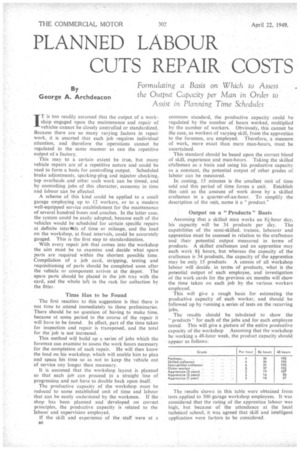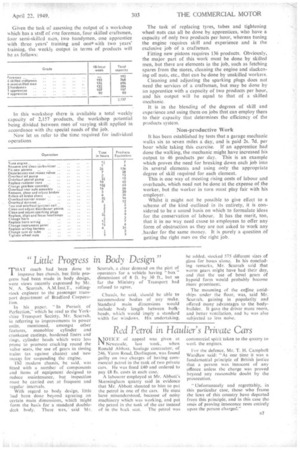PLANNED LABOUR
Page 14

Page 15

If you've noticed an error in this article please click here to report it so we can fix it.
CUTS REPAIR COSTS Formulating a Basis on Which to Assess the Output Capacity per Man in Order to Assist in Planning Time Schedules George A. Archdeacon IT is too readily assumed that the output of a workshop engaged upon the maintenance and repair of vehicles cannot be closely controlled or standardized. Because there are so many varying factors in repair work, it is asserted that each job requires individual attention, and therefore the operations cannot be regulated in the same manner as can the repetitive output of a factory.
This may to a certain extent be true, but many vehicle repairs are of a repetitive nature and could be used to form a basis for controlling output. Scheduled brake adjustments. sparking-plug and injector checking, top overhauls and other such work can be timed, and by controlling jobs of this character, economy in time and labour can be effected.
A scheme of this kind could be applied to a small garage employing up to 12 workers, or to a modern well-equipped service establishment for the maintenance of several hundred buses and coaches. In the latter case, the system could be easily adopted, because each of the vehicles would be scheduled for certain specific repairs at definite interittis of time or mileage, and the load on the workshop, at fixed intervals, could be accurately gauged. This is the first step to standardization.
With every repair job that comes into the workshop the aim must be to examine and decide what spare parts are required within the shortest possible time. Compilation of a job card, stripping, testing and requisitioning of parts should be completed soon after the vehicle or component arrives at the depot. The spare parts should be placed in the job tray with the card, and the whole left in the rack for collection by the fitter.
Time Has to be Found
The first reaction to this suggestion is that there is not time to attend immediately to these preliminaries. There should be no question of having to make time, because at some period in the course of the repair it will have to be found. In effect, part of the time taken for inspection and repair is transposed, and the total for the job is not increased.
This method will build up a series of jobs which the foreman can examine to assess the work hours necessary for the completion of each repair. He will then know the load on his workshop, which will enable him to plan and space his time so as not to keep the vehicle out of service any longer than necessary.
It is assumed that the workshop layout is planned so that each job can proceed in a straight line of progression and not have to double back upon itself.
The productive capacity of the workshop must be reduced to some established unit of time and labour that can be easily understood by the workmen. If the shop has been planned and developed on correct principles, the productive capacity is related to the labour and supervision employed.
If the skill and experience of the staff were at a common standard, the productive capacity could be regulated by the number of hours worked, multiplied by the number of workers. Obviously, this cannot be the case, as workers of varying skill, from the apprentice to the foreman, are employed. Therefore, a measure of work, more exact than mere man-hours, must be ascertained.
This standard should be based upon the correct blend of skill, experience and man-hours. Taking the skilled craftsman as a basis and using his productive capacity as a constant, the potential output of other grades of labour can be measured.
In costing, 15 minutes is the Smallest unit of time sold and this period of time forms a unit. Establish this unit as the amount of work done by a skilled craftsman in a quarter-of-an-hour. To simplify the description of the unit, name it a "product."
Output on a " Products " Basis Assuming that a skilled man works an 8i-hour day, his capacity will be 34 products per day. The capabilities of the semi-skilled, trainee, labourer and apprentice must be assessed in relation to the craftsman and their potential output measured in terms of products. A skilled craftsman and an apprentice may each work n hours, but whereas the capacity of the craftsman is 34 products, the capacity of the apprentice may be only 15 products. A census of all workshop labour will decide. in terms of products, what is the potential output of each employee, and investigation of the work cards for the previous six months will show the time taken on each job by the various workers employed.
This will give a rough basis for estimating the productive capacity of each worker, and should be followed up by running a series of tests on the recurring jobs.
The results should be tabulated to show the " products" for each of the jobs and for each employee tested. This will give a picture of the entire productive capacity of the workshop Assuming that the workshop be working a 48-hour week, the product capacity should appear as follows: The results shown in this table were obtained from tests applied to 300 garage workshop employees. It was considered that the rating of the apprentice labour was high, but because of the attendance at the local technical school, it was agreed that skill and intelligent application were factors to be considered. Given the task of assessing the output of a workshop which has a staff of one foreman, four skilled craftsmen, four semi-skilled men, two handymen, one apprentice with three years' training and one' with two years' training, the weekly output in terms of products will be as follows: In this workshop there is available a total weekly capacity of 2,157 products, the workshop potential being divided between men of varying skill applied in accordance with the special needs of the job.
. Now let us refer to the time required for individual operations. The task of replacing tyres, tubes and tightening wheel-nuts can all be done by apprentices, who have a capacity of only two products per hour, whereas tuning the engine requires skill and experience and is the exclusive job of a craftsman.
Fitting new pistons requires 136 products. Obviously, the major part of this work must be done by skilled men, but there are elements in the job, such as fetching spares from the stores, cleaning the engine and slackening off nuts, etc., that can be done by unskilled workers.
Cleaning and adjusting the sparking plugs does not need the services of a craftsman, but may be done by an apprentice with a capacity of two products per hour, and his output will be equal to that of a skilled mechanic.
It is in the blending of the degrees of skill and experience and using them on jobs that can employ them to their capacity that determines the efficiency of the products system.
Non-productive Work
It has been established by tests that a garage mechanic walks six to seven miles a day, and is paid 2s. 7d. per hour while taking this exercise. If an apprentice had done the walking, the mechanic might have increased his output to 46 products per day. This is an example which proves the need for breaking down each job into its several elements and using only the appropriate degree of skill required for each element.
This is one way of meeting rising costs of labour and overheads, which need not be done at the expense of the worker, but the worker in turn must play fair with his employer,
Whilst it might not be possible to give effect to a scheme of the kind outlined in its entirety, it is considered to be a sound basis on which to formulate ideas for the conservation of labour.. It has the merit, too, that it in no way need cause to employees to offer any form of obstruction as they are not asked to work any ,harder for the same money. It is purely a question of getting the right men on the right job.


























